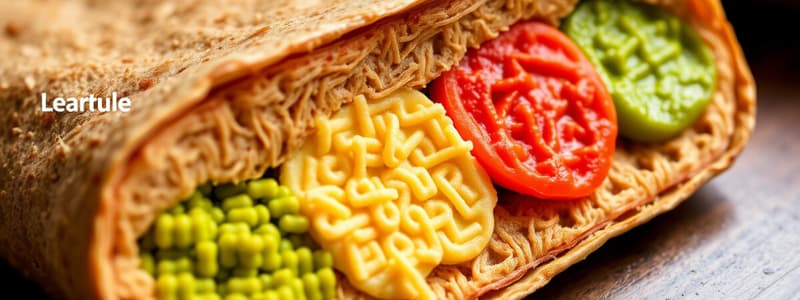Podcast
Questions and Answers
What are the five basic tastes?
What are the five basic tastes?
Sweet, sour, salty, bitter, and umami.
How can cooking techniques influence food texture?
How can cooking techniques influence food texture?
Different cooking techniques, like frying or steaming, alter the texture of foods.
What is a flavor combination example that blends different tastes?
What is a flavor combination example that blends different tastes?
Sweet and salty is an example of a flavor combination.
What role does texture play in food enjoyment?
What role does texture play in food enjoyment?
What can influence taste perception aside from food itself?
What can influence taste perception aside from food itself?
Name two basic textures in food and give examples.
Name two basic textures in food and give examples.
Why is textural analysis important in the food industry?
Why is textural analysis important in the food industry?
How do cultural influences affect taste classification?
How do cultural influences affect taste classification?
Study Notes
Classifying Objects According to Taste and Texture
Taste Classification
-
Basic Tastes:
- Sweet: Sugars, honey, some fruits.
- Sour: Acids, citrus fruits, vinegar.
- Salty: Sodium chloride, sea salt, table salt.
- Bitter: Caffeine, dark chocolate, certain vegetables (e.g., kale).
- Umami: Savory flavors, glutamate-rich foods (e.g., tomatoes, mushrooms).
-
Taste Profiles:
- Flavor Combinations: Mixing tastes to create unique profiles (e.g., sweet and salty).
- Cultural Influence: Different cultures may classify tastes based on traditional flavors (e.g., spicy, herbal).
-
Taste Perception:
- Influenced by individual genetics, age, and health.
- Can be affected by smell and visual appearance of food.
Texture Classification
-
Basic Textures:
- Crunchy: Hard, crisp foods (e.g., chips, raw vegetables).
- Chewy: Requires significant effort to break down (e.g., meats, chewy candies).
- Creamy: Smooth and rich (e.g., yogurt, ice cream).
- Smooth: Soft and consistent texture (e.g., puddings, sauces).
- Gritty: Coarse, grainy feel (e.g., certain cheeses, sand in food).
-
Texture in Cooking:
- Cooking Techniques: Methods (e.g., frying, steaming) can alter texture.
- Ingredient Interactions: Combining different textures can enhance overall experience (e.g., crunchy topping on creamy casserole).
-
Texture Perception:
- Influenced by mouthfeel, temperature, and moisture content.
- Plays a significant role in food enjoyment and satisfaction.
Applications
- Culinary Arts: Chefs combine various tastes and textures to create balanced dishes.
- Food Industry: Textural analysis is crucial for product development and quality control.
- Sensory Evaluation: Professionals assess food based on taste and texture to determine consumer preferences.
Conclusion
- Classifying objects by taste and texture enhances understanding of food characteristics and can improve culinary experiences.
Taste Classification
-
Basic Tastes encompass five primary categories:
- Sweet: Derived from sugars, honey, and certain fruits.
- Sour: Associated with acids found in citrus fruits and vinegar.
- Salty: Defined by the presence of sodium chloride, found in sea salt and table salt.
- Bitter: Includes substances like caffeine and dark chocolate, and vegetables such as kale.
- Umami: Describes savory flavors, particularly those rich in glutamate like tomatoes and mushrooms.
-
Taste Profiles:
- Flavor Combinations: Mixing tastes, like sweet and salty, to craft unique flavor experiences.
- Cultural Influence: Taste classifications vary by culture, incorporating traditional elements like spicy or herbal notes.
-
Taste Perception:
- Influenced by genetics, age, and overall health of the individual.
- Smell and visual presentation of food significantly impact taste experiences.
Texture Classification
-
Basic Textures consist of several distinct categories:
- Crunchy: Hard and crisp, typical of snacks like chips and raw vegetables.
- Chewy: Foods that require more effort to break down, such as meats and chewy candies.
- Creamy: Smooth and rich textures found in items like yogurt and ice cream.
- Smooth: Soft, consistent textures, seen in puddings and sauces.
- Gritty: Coarse and grainy textures found in certain cheeses or food containing sand.
-
Texture in Cooking:
- Cooking Techniques: Different methods, such as frying or steaming, can drastically change food texture.
- Ingredient Interactions: Combining varied textures (e.g., a crunchy topping on a creamy casserole) can elevate the culinary experience.
-
Texture Perception:
- Influenced by mouthfeel, temperature, and moisture content, playing a crucial role in food enjoyment.
Applications
- Culinary Arts: Chefs skillfully blend various tastes and textures to achieve harmonious dishes.
- Food Industry: Textural analysis is vital for developing products and ensuring quality control.
- Sensory Evaluation: Professionals utilize taste and texture assessments to gauge consumer preferences.
Conclusion
- Classifying objects by taste and texture enhances comprehension of food characteristics, contributing to improved culinary experiences.
Studying That Suits You
Use AI to generate personalized quizzes and flashcards to suit your learning preferences.
Description
Test your knowledge on the classification of food based on taste and texture! This quiz covers basic tastes like sweet and sour, as well as texture profiles such as crunchy and creamy. Learn how cultural influences shape our perception of flavors and food textures.




